Mini excavator composition & characteristics
1. Composition
Chassis:
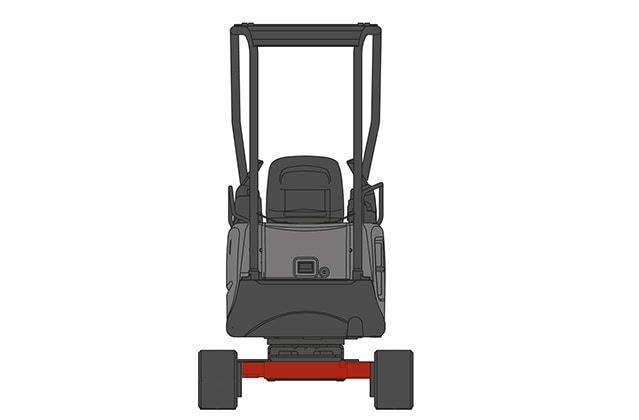
Several components make up the mini excavator. The first is the chassis.
This supports the rubber tracks. It is made up of a mechanically welded structure, usually in the shape of an 'X'. It is mounted on the undercarriage that carries the tracks (rubber or steel). These ensure the stability of the mini excavator as well as enabling it to move. The upper rollers are located at the top of the undercarriage. Their role is to guide the tracks. Depending on the mini excavator you choose, their number and shape may differ. It is thus important to check compatibility if you ever need to buy upper rollers.
The travel motor is located at each end of the track frame. Also known as geared motors, they provide the torque needed for the mini excavator to move over all types of terrain.
The drive sprockets engage with the tracks. They can be found secured to the travel motor. These parts transmit the torque from the travel motor to the track so that the mini excavator can move forwards, backwards or even rotate.
The lower rollers are located at the bottom of the undercarriage. Their function is to support the tracks. As with the upper rollers, it is important to refer to the manufacturer's instructions on shapes, numbers and dimensions.
The idler wheels are at the front of the tracks, which provide tension. It is essential that they are in perfect condition to prevent any damage to the tracks.
Upper frame:
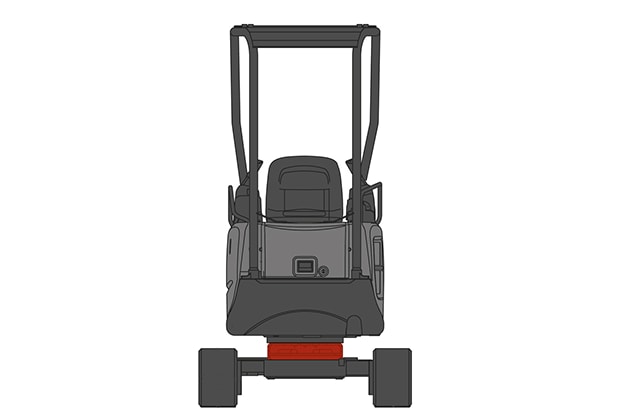
It carries the tool and cab, the engine and hydraulic system. Controls are generally provided by hydraulically, mechanically or electrically operated valves.
It is driven by a hydraulic rotation motor that allows it to turn infinitely in both directions. Mini excavators are equipped with a boom swing offset (additional vertical pivot link on the outside of the turret where the upper frame is attached). This means it can be offset to work in the tightest spaces or flush with a wall.
The cab or canopy:
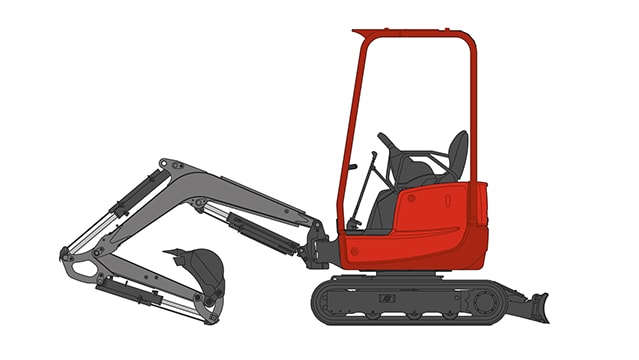
If you plan to use your mini excavator all year round, we recommend you opt for the cab. It will be very useful for winter work, thanks in particular to its windows and heating. The canopy is easy to access and offers excellent visibility. It provides optimum protection for the operator in the event of a tip-over. Your region of residence will certainly influence your choice in this respect. There are many more mini excavators with canopies in southern regions and cab versions in northern regions.
Hinged arm:
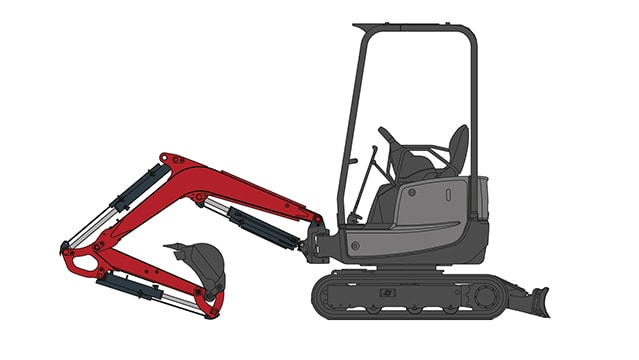
As its name suggests, the mini excavator's arm roughly imitates the human arm. Its role is to grab and move loads, using an attachment (bucket, grapple, etc.), hydraulic cylinders and the mechanical articulation of the boom.
The boom swing is located at the front of the cab (usually centred on the upper frame). It is articulated to offset the bucket without the upper frame pivoting.
The boom is connected to the dipperstick
The dipperstick is located between the boom and the attachment. If the dipperstick is short, the digging force and lifting capacity will be high. It is therefore better suited to demanding jobs such as earthmoving or demolition. Long dippersticks are used for levelling and pipe work and give a higher digging depth.
Engine:
The mini excavator engine is generally small, light and powerful, with a high torque capacity to facilitate digging in difficult terrains.
It can be powered by different types of fuel, including petrol, diesel or electricity. Diesel engines are the most common, offering high power and torque with relatively low fuel consumption. Regular maintenance is crucial to keep your mini excavator engine running smoothly.
Hydraulic system:
It gives operators greater control over the accessories. The machine can be fitted with 2 auxiliary hydraulic lines at the end of the dipperstick. They are connected to tools such as hydraulic hammers, grapples, clamps, etc. The oil is set in motion by a pump. It passes through a distributor that directs the flow to the cylinders to be activated, with the oil pushing the rod in one direction or the other.
Quick coupler:
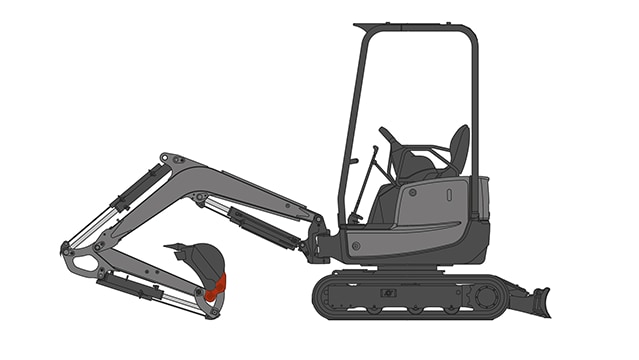
The quick coupler system allows accessories to be fitted to the mini excavator's hinged arm. This makes replacing buckets or accessories much easier. It is used as an adapter to be fitted to the ends of a hinged arm. It saves the operator from having to carry out excessive handling, so work can be carried out in greater safety. There are different types of quick couplers: manual or hydraulic. It is essential that the attachment system on the mini excavator and the bucket attachment are compatible and fit perfectly.
Bucket:
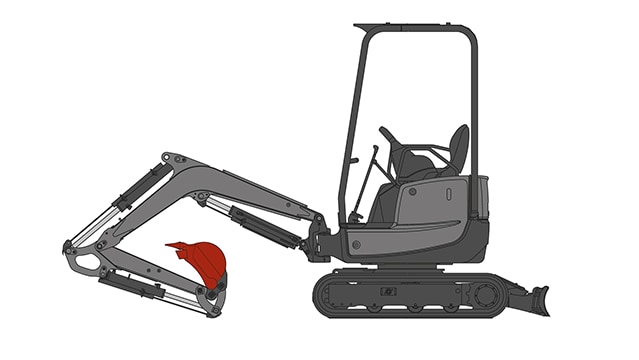
The bucket is a removable accessory that attaches to the end of the mini excavator's hinged arm. It changes depending on the work to be carried out, whether it involves construction, demolition, mining, earthworks, the environment, sanitation or agriculture. It can be used for small operations as well as heavy works. The dimensions and size of the bucket vary according to the chosen model.
It is generally made up of five main components:
- the back of the bucket
- the bottom of the bucket
- a basic blade
- side walls
- a side wall blade
Levelling blade:
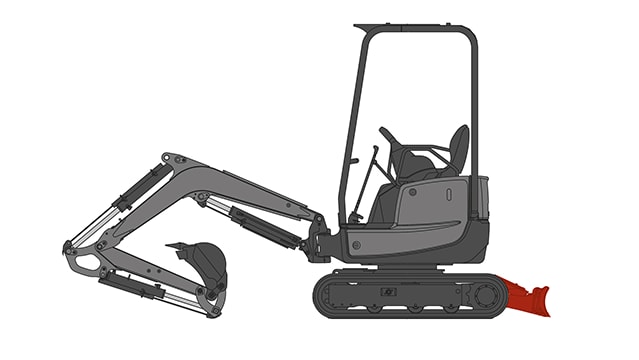
Located at the front of the mini excavator, it will enable you to level or backfill a trench, for example. You can backfill a hole by pushing out the excavated earth and level the ground. It is best to carry out multiple operations to avoid putting too much strain on the blade. The tracks will also help to compact the soil. For best results, it is advisable to move forward at a steady pace and without sudden movement when the blade is lowered. Its main function is to stabilise the mini excavator by providing better support and greater stability for the machine. Once in the right position, lower the blade into the ground, which will feel less jarring as the machine manoeuvres.
Tracks:
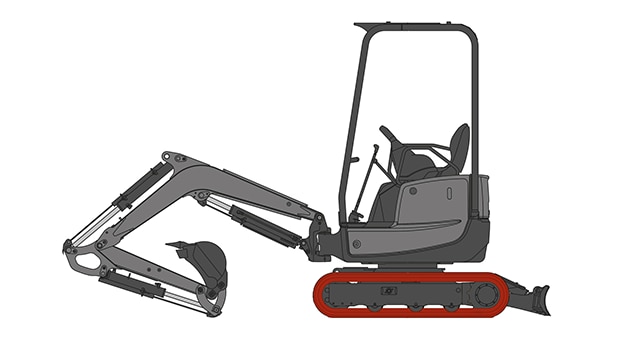
Most mini excavators are equipped with rubber tracks. The wider the tracks, the lower the ground pressure. For work in marshes, wide tracks will be useful. For hard terrain, narrower tracks are required.
The wider the tracks, the greater the wear and tear and the greater the risk of damage to the ground. The ideal width is a compromise. It should be as narrow as possible and as wide as necessary!
The longer and wider the tracks, the more stable the machine. On certain models of the mini excavator, it is possible to retract the track width for transport purposes.
2. Characteristics:
There are a number of characteristics to help you choose your mini excavator. The main points to be considered are:
- Arm digging force
- Bucket digging force
- Dimensions
- Digging depth
- Compactness
- Flow on auxiliary lines
- Auxiliary line pressure
- Maximum unloading height
- Travel speed
- Transport weight
- Type of engine
The digging forces of the arm and bucket will give you the power and efficiency you need for different works. They are calculated in Newton kilograms.
To squeeze through narrow passages and spaces, you will need a space-saving machine. Manufacturers give very precise information on the dimensions of mini excavators in the product data sheets that you can download from their website. It all depends on how you use it.
The digging depth and maximum unloading height give an indication of the size of the work that can be done with the mini excavator. The longer the arm, the fewer manoeuvres you will have to perform on medium- and large-scale operations. On the other hand, on a small site, having a long arm will limit the field of action and may make the work more difficult.
The compactness of the machine can be calculated using the dimensions of the mini excavator, and also by whether or not it has a retractable chassis. When the chassis can be widened, the machine has a smaller rear offset. Also take into account the front and rear turning radius and the retracted chassis width. The benefits of compactness will be easier access to restricted areas and the ability to pass through doorways, for example, in housing renovations.
Hydraulic flow rate: the greater the flow rate, the greater the digging speed of the mini excavator. If the hydraulic flow is too low, the mini excavator will take longer to react.
The weight of the mini excavator will vary between 750 kg and 1.5 tonnes. It will determine whether the product is for private or professional use. This range is suitable for both private use (small foundations, stump removal, landscaping, etc.) and professional use (trenching, augering fences, etc.).
Mini excavators weighing over 1,500 kg are used by professionals for medium to large-scale projects (earthworks, building swimming pools, foundations, laying drains, etc.). Another question to ask yourself: do you intend to transport it on a trailer?
Finally, the type of engine fitted to the mini excavator must provide the power and torque required to use the machine. Some users are sensitive to silence, fuel consumption and engine emissions. This must comply with European regulations.
Finally, daily maintenance checks will be easier and quicker if your engine is easily accessible.